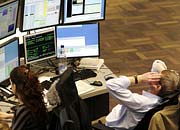
With food prices rising, it is not just the world that is hungry for grain. So are investors.
Trading in commodities such as wheat and corn is booming.
The Chicago Board of Trade (CBOT) was set up in 1848 to allow farmers to buy grain.
These days it still brings together buyers and sellers although you do not see any actual grain.
Here, the prices of wheat, corn and soybeans are set daily on the trading floor.
Minute by minute deals are made.
The largely male crowd, dressed in bright jackets denoting which company they work for, yell prices at the top of their lungs.
The trading takes place around a pit – each one represents a different commodity – such as wheat or corn.
From the outside it looks like chaos: a blur of hand signals, bits of paper flung across the floor.
Investors dive in
“We are seeing record activity by non-industry participants”
CBOT trader Randy Mittelstaedt
Q&A: Rising world food prices
This whirlwind of activity only lasts a short while.
The trading day is just four hours.
In that fixed period of time, traders are being asked to handle ever greater volumes.
Put simply, the number of deals being done in any given day is going up.
The reason is simple. The sharp increase in the price of commodities has attracted a new breed of investors who sense the opportunity to make a profit.
Suddenly pension funds and hedge funds are investing more and more here.
“We are seeing record activity by non-industry participants,” says trader Randy Mittelstaedt.
With 15 years experience of these markets, he believes “there’s a lot of money moving into the markets that are simply looking at it from an investment perspective”.
Record prices

The commodity that has been generating a lot of interest lately is wheat. Combine harvester
The price of this food staple, which is used in bread and animal feed, has been soaring.
Driving it up is reduced supply, with drought affecting crops in Australia.
However supply is not the only factor.
The world population has grown and so has demand from the Far East.
Another reason prices are going up is that wheat is being used for biofuels.
The combination of these factors has resulted in the price of wheat more than doubling over the last year.
Why does any of this matter?
Crop prices influence what farmers decide to plant.
If wheat offers a higher return, they may decide to devote more acreage to that crop at the cost of others such as soybeans, pushing up their prices too.
Vic Lespinasse is a veteran trader who has worked at the CBOT for 35 years.
When asked about the future direction of prices he says “to expect the unexpected”, adding that “the weather will determine what happens over the course of this year”.
By Michelle Fleury
BBC News, Chicago
Tuesday, 11 March 2008, 10:41 GMTSource: BBC NEWS